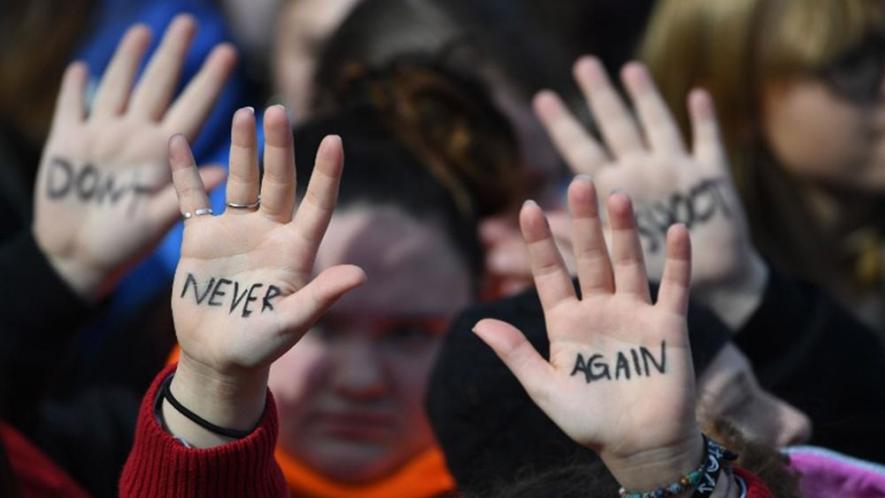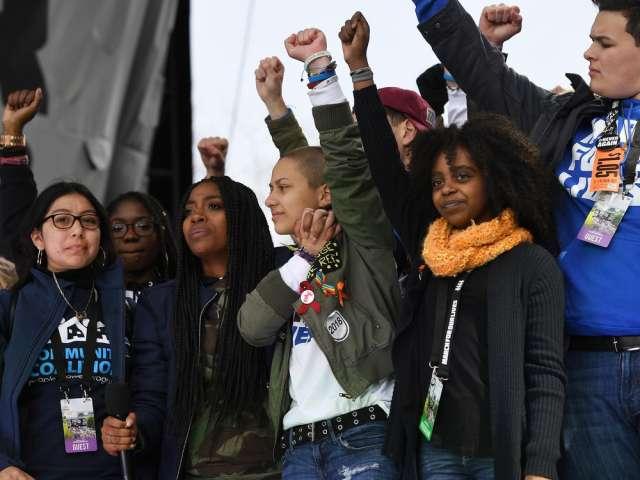March for Whose Lives?

Image Courtesy: News 96.5
This week in the United States, the ‘March For Our Lives’ has been dominating the headlines. After a mass shooting at Marjory Stoneman Douglas High School in Parkland, Florida on February 14, the students who survived the attack vowed that “We will be the last mass shooting.” They organized a march to Washington D.C. on Saturday, March 24 to demand gun reform and inspired at least 1.2 million people nationwide to organize marches around the country under the rallying cry “March for Our lives”. It is the largest youth protest in the U.S. since the anti-war protests during the Vietnam War. An estimated 1.2 million people across the United States participated in the March for Our Lives to bring awareness about gun violence in the US and demand the legislative bodies to tighten gun control laws.
In the United States this month, protests have erupted against all kinds of gun violence, from school shootings to police shootings. Youth survivors of the Parkland School Shooting have connected the dots between all victims of gun violence, but the media and national outrage slow to follow suit.
At the March for Our Lives, 11-year-old Naomi Wadler said in a passionate speech, "I am here today to represent Courtlin Arrington. I am here today to represent Hadiya Pendleton. I am here today to represent Taiyania Thompson, who, at just 16, was shot dead in her home here in Washington, D.C. I am here today to acknowledge and represent the African-American girls whose stories don’t make the front page of every national newspaper, whose stories don’t lead on the evening news. I represent the African-American women who are victims of gun violence, who are simply statistics instead of vibrant, beautiful girls full of potential."

Activists have long been fighting gun violence in many forms. April 29-- one month from now-- will mark 26 years since the 1992 LA Riots, when the city erupted in protest in response the acquittal of the police beating and arrest of Rodney King. Police violence and gun violence in America are not new. Both these activists and victims are often criminalised and shamed by the media. Their resistance and protests are termed as violence, their very existence perceived as threatening. The national outrage over the victims of school shootings has not extended to the victims of police brutality.
Just six days before the March for Our Lives, 22-year-old Stephon Clark was murdered outside his home by police who claimed that the iphone in his hand was threatening enough to justify the 20 rounds they shot at him. Clark left behind two young children, children who will grow up without a father. Following his death in his backyard in Sacramento, protests have erupted across the city. But the numbers and media coverage do not come close to the March for Our Lives.
Just three days after the March of Our Lives, the verdict came out on March 27 that the police personnel who killed Alton Sterling will not be charged. Sterling, an African American man, was shot to death by two white police officers at close range while selling CD’s outside of a store.
Despite the voices of 11-year-old Naomi Wadler, Yolanda Renee King, the 9-year-old granddaughter of Martin Luther King Jr., and other youth speaking up for all types of gun violence-- from school shootings to “officer involved shootings”-- the media coverage has all but erased this from the narrative.
So far in 2018-- in just under 3 months-- 3,308 people have been killed as a result of gun violence. Of those deaths, 50 were killed in mass shootings. 547 were killed in “officer involved” shootings. The culture in America is one that breeds fear. Children grow up doing drills of what to do in case of an active shooter, of where to hide. Teachers are pressured to carry guns to shoot back to save the children. Black parents have “the talk” with their children, what to do if they are pulled over by the police- Yes ma’am. Yes sir. May I please take out my registration, sir. Please don’t shoot, sir.
As the American people battle gun violence, we must hold at the center of this conversation all victims of gun violence. The 17 High School students who were killed in the Parkland shooting by a former student. The 9 victims of the Charleston Church Shooting, ages 26 to 74, by a vowed white supremacist. Michael Brown (18), killed by the Ferguson police. Aiyana Jones (7), killed by the Detroit police. Tamir Rice (12), killed by the Cleveland police. Trayvon Martin (17), killed by a Florida neighborhood watchman. The 5-year-old son of Korryn Gaines, killed by the Chicago police, who will now grow up without a mother. The five children of Alton Sterling, killed by Baton Rouge Police, who will now grow up without a father. The list goes on.
Disclaimer: The views expressed here are the author's personal views, and do not necessarily represent the views of Newsclick.
Get the latest reports & analysis with people's perspective on Protests, movements & deep analytical videos, discussions of the current affairs in your Telegram app. Subscribe to NewsClick's Telegram channel & get Real-Time updates on stories, as they get published on our website.














